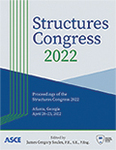AFRP Reinforced Concrete Column with Controlled Rocking Connection
Publication: Structures Congress 2022
ABSTRACT
AFRP bars have experienced premature rupture under concentric loads due to their anisotropic properties, limiting their usage in compression members. A limited number of studies have been conducted on the reliability of implementing energy dissipaters to prevent the rupture of AFRP longitudinal bars in compression. However, the research to date has failed to emphasize the influence of rocking connection and size of replaceable fuse on the performance of the column. This research explored the strategy of designing the AFRP-reinforced concrete (AFRP-RC) column to remain elastic while incorporating external replaceable fuses as sacrificial elements to dissipate energy and reduce damage. A three-dimensional finite element model was developed and validated. An extensive parametric analysis was performed on 100 numerical models with a typical column size. Enhanced performance of the AFRP-RC controlled rocking system in terms of ductility, energy dissipation, damage index, and work index was found. Key design parameters of replaceable fuses that influence the cyclic performance of the column were identified. A set of equations are proposed to assist in designing the controlled rocking columns with replaceable fuses.
Get full access to this article
View all available purchase options and get full access to this chapter.
REFERENCES
ACI (American Concrete Institute). (2015). Guide for the design and construction of structural concrete reinforced with FRP bars, Committee 440.1R-15. Farmington Hills, MI.
ANSYS. (2012). ANSYS Manual. Canonsburg, PA.
Bangash, M. Y. (1989). Concrete and concrete structures: Numerical modeling and applications. 22(12), 687.
Bathe, K. J. (1996). Finite element procedures. Upper Saddle River, New Jersey: Prentice-Hall, Inc.
Deierlein, G. G., Krawinkler, H., and Ma, X. (2011). “Earthquake resilient steel braced frames with controlled rocking and energy dissipating fuses.” Steel Construction, 4(3), 171–175.
Deitz, D. H., Harik, I. E., and Gesund, H. (2003). “Physical properties of glass fiber reinforced polymer rebars in compression.” Journal of Composite for Construction, 7(4), 363–366.
Desayi, P., and Krishnan, S. (1964). “Equation for the stress-strain curve of concrete.” Journal Proceedings, 61(3), 345–350.
Dolan, C. W. (1993). FRP development in the United States. In A. Nanni, Fiber-reinforced-plastic reinforcement for concrete structures: Properties and applications (pp. 129–166). Amsterdam: Elsevier Science Publishers B.V.
Efe, S., Shokouhian, M., Head, M., and Chinaka, E. (2017). “Numerical study on the cyclic response of AFRP reinforced columns with externally unbonded energy dissipaters.” Structure and Infrastructure Engineering, 14(2).
Filiatrault, A., Wanitkorkul, A., and Constantinou, M. (2008). Development and appraisal of a numerical cyclic loading protocol for quantifying building system performance. The University at Buffalo, State University of New York: MCEER: Earthquake Engineering to Extreme Events.
Gere, J. M., and Timoshenko, S. P. (1997). Mechanics of materials. Boston, Massachusetts: PWS Publishing Company.
Gibson, R. F. (1994). Principles of composite material mechanics. New York: McGraw-Hill Inc.
Housner, G. W. (1963). “The behavior of inverted pendulum structures during earthquake.” Bulletin of the Seismological Society of America, 53(2), 403–417.
Kachlakev, D., Miller, T., Yim, S., Chansawat, K., and Potisuk, T. (2011). Finite element modeling of reinforced concrete structures strengthened with FRP laminates.
Kaw, A. K. (1997). Mechanics of composite materials. Boca Raton, Florida: CRC Press LLC.
Kawaguchi, N. (1993). “Ultimate strength and deformation characteristics of concrete members reinforced with AFRP rods under combined axial tension or compression and bending.” ACI Special Publication, 138, 671–685.
Krawinker, H. (1996). “Cyclic loading histories for seismic experimentation on structural” components. Earthquake Spectra, 12(1).
Lu, L., Liu, X., Chen, J., and Lu, X. (2017). “Seismic performance of a controlled rocking reinforced concrete frame.” Advances in Structural Engineering, 20(1), 4–17.
Mander, J. B., and Cheng, C. T. (1997). Seismic resistance of bridge piers based on damage avoidance design. The State University of New York. Buffalo: National Centre for Earth. Eng. Research.
Mazzolani, F. M., and Piluso, V. (1993). Member behavioural classes of steel beams and beam-columns.
Osorio, L. I., Paultre, P., Eid, R., and Proulx, J. (2014). “Seismic behavior of synthetic fiber-reinforced circular columns.” ACI Structural Journal, 111(1), 189–200.
Palermo, A., and Pampanin, S. (2008). “Enhanced seismic performance of hybrid bridge systems: comparison with traditional monolithic solutions.” Journal of Earthquake Engineering, 12(8), 1267–1295.
Park, J.-S., Lim, A.-R., and Lee, J.-Y. (2016). “Bond performance of fiber-reinforced polymer rebars in different casting positions.” Polymer Composites, 37(7), 2098–2108.
Priestley, M. J., and MacRae, G. A. (1996). “Seismic tests of precast beam-to-column joint sub-assemblages with unbonded tendons.” PCI Journal, 41(1), 64–81.
Ronagh, H. R., and Baji, H. (2014). “On the FE modeling of FRP-retrofitted beam-column subassemblies.” International Journal of Concrete Structures and Materials, 8(2), 141–155.
Sharbatdar, M., and Saacioglu, M. (2009). “Seismic design of FRP reinforced concrete structures.” Asian Journal of Applied Science, 2(3), 221–222.
Wang, Y., Cai, G., Li, Y., Waldmann, D., Si Larbi, A., and Tsavdaridis, K. D. (2019). “Behavior of Circular Fiber-Reinforced Polymer-Steel-Confined Concrete Columns Subjected to Reversed Cyclic Loads: Experimental Studies and Finite-Element Analysis.” Journal of Structural Engineering, 145(9).
Wu, Z., Wang, X., and Wu, G. (2012). Advancement of Structural Safety and Sustainability with Basalt Fiber Reinforced Polymers. 6th International Conference on FRP Composites in Civil Engineering. Rome, Italy.
Information & Authors
Information
Published In
History
Published online: Apr 18, 2022
Authors
Metrics & Citations
Metrics
Citations
Download citation
If you have the appropriate software installed, you can download article citation data to the citation manager of your choice. Simply select your manager software from the list below and click Download.
